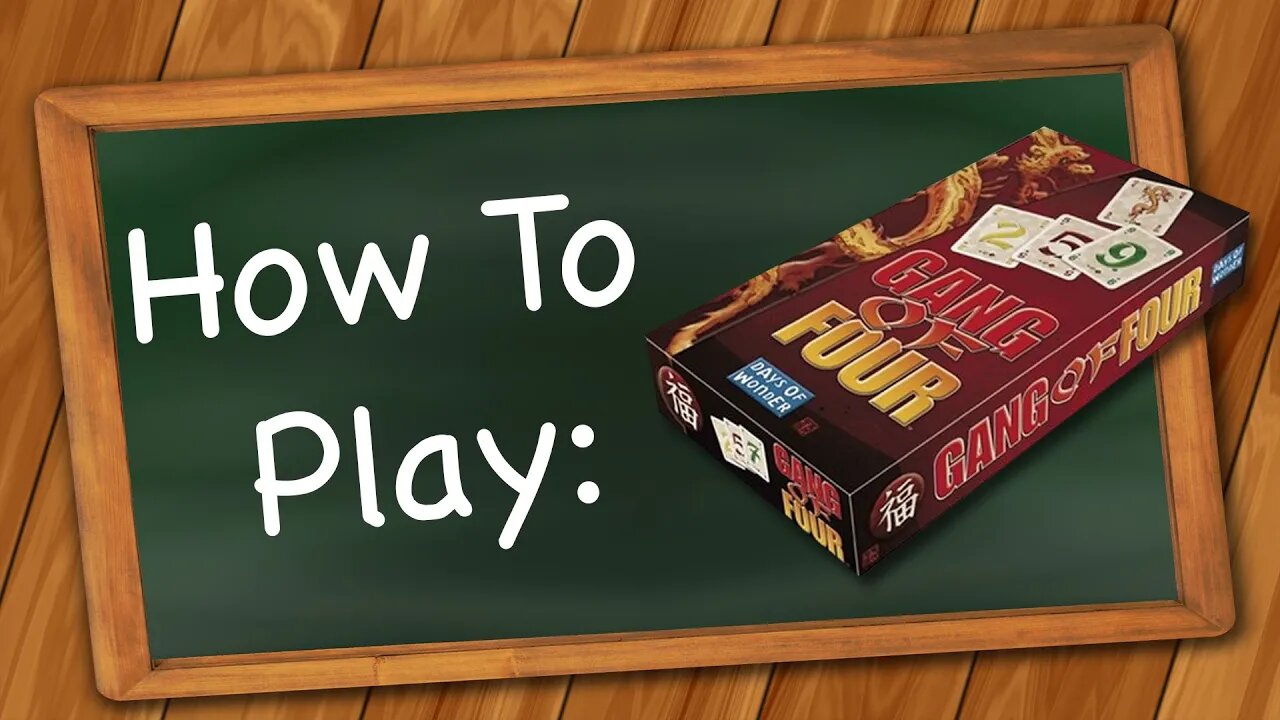Premium Only Content

How to play Gang of Four
Learn the rules to the card game Gang of Four quickly and concisely - This visually rich video has no distractions, just the rules.
Don't own the game?
Buy it here: https://amzn.to/2Y9zg5V (This Amazon Affiliate link directly supports me)
RULES:
The object of the game is to have the lowest score when the first player reaches 100 points. The object of each round is to be the first player to play all your cards. The oldest player shuffles and deal out the entire deck to each player. If you are playing with 3 players, one extra “dummy” hand that will not be used. After each hand is complete, shuffle the dummy hand and re-deal it.
The first hand of the game the player with the multi-colored 1 goes first and must include that 1 in their play. The winner of each hand deals and starts the next. Each player then in turn, plays a combination of cards made of the same number of cards as the opening combination in a higher rank or passes. The allowed combinations of cards that can be played are:
Single cards: any single card.
Pairs: two cards of the same number.
Three of a kind: three cards of the same number.
Five Card combinations including:
Straight: 5 number cards in sequential order
Flush: 5 number cards of the same color
Full house: a pair plus a three of a kind
Straight flush: 5 number cards of the same color in sequential order.
Gang of 4: 4 or more cards of the same number, the more cards the more powerful.
There are 2 cards for each number from 1 to 10 in three suits, red, yellow and green, with one multicolored 1 which is the highest of all ones, and two phoenixes, which rank higher than the 10, and one dragon, which is the highest single card. Suit strength descends like a street light. Red is the highest, followed by yellow, and green is the lowest.
Higher ranks beat lower ranks. A 7 is stronger than a 6 no matter the color. If the numbers are the same, then color value decides. A red 6 beads a yellow 6. A higher 5 card combination beats a lower 5 card combination. A full house beats a straight. Finally, a gang of four beats any ranked card or card combination of any cards at any time. Only a higher ranking gang of four, or a gang of five, six, or seven can beat a lower Gang of Four.
On your turn you must play cards equal to the number of cards lead unless it is a gang of four. If a player leads pairs, you cannot play a 5 card combination, you must play 2 cards of a higher rank, a gang of four, or pass your turn. You may choose to pass even if you have cards that could be played. All play is always optional. If you pass you may play later if given another opportunity to play.
When every player consecutively passes so that a player must play on his own card, that player has won the cycle. All cards played are left face up in a pile in the middle of the table. You are not allowed to touch or peak at any of the discarded cards. The player who won the cycle, starts the new cycle with any card combination he chooses.
The process repeats until a player lays down his last card. Play immediately stops and points are scored based on how many cards remain in each player’s hand. You receive 1 point per card in your hand if you have 1-7 cards left at the end of the hand. You receive 2 points per card if you have 8-10 cards left. 3 points per card if you have 11-13. 4 points per card if you have 14-15 cards left. And 80 points if you have all 16 cards left at the end of a hand.
Use the score pad to record the number of points for each hand. Once the scores are recorded the cards are gathered, shuffled and redelt. Once a player reaches 100 points, the game ends and the player with the lowest score wins.
At the beginning of each hand, except for the first, and before the new hand has begun, the loser of the previous hand, the person who gained the most points, must give to the winner of the previous hand their highest single card. The winner then gives the loser whatever card he wants. Both cards are shown to all players. In the case of a tie for the loser of the previous round, then the player with the highest total score is chosen. If that is still a tie, then the player clostest to the winner counterclockwise is chosen.
When a player is down to their last remaining card in their hand, they must declare “Last card”. If a player fails to do so, they are not allowed to win this hand and play continues amongst the other players until an alternate winner is decided. The player who failed to declare his last card adds one point to his score total for the hand.
If a player goes out by playing a card combination other than single cards, no “Last Card” declaration is required. Players can always ask how many cards another player has remaining.
Finally, the player sitting immediately before the “last card” player must play his highest ranking single card first, if single cards are being played. Likewise, that player must open new cycles in the hand with combinations other than single cards if he can do so...
-
 2:21
2:21
Triple S Games
1 year ago $0.06 earnedHow to play Cruise Pawns
961 -
 1:47
1:47
Bitola2021
3 years agofour baby kittens play
69 -
 3:34
3:34
Triple S Games
3 years ago $0.01 earnedHow to play Ginnykub
171 -
 0:28
0:28
Triple S Games
3 years agoHow to play Heardle
25 -
 0:44
0:44
Triple S Games
3 years agoHow to play Hippodrome
27 -
 0:34
0:34
Triple S Games
3 years ago $0.02 earnedHow to play Nerdle
48 -
 2:17:08
2:17:08
FreshandFit
5 hours ago10 Top Red Pills About American Women
37K16 -
 2:10:26
2:10:26
Badlands Media
10 hours agoDevolution Power Hour Ep. 383
49.2K6 -
 3:17:28
3:17:28
TimcastIRL
5 hours agoTrans Shooter Targets Catholic Kids In Mass Shooting, Leftists Reject Prayers | Timcast IRL
210K54 -
 1:31:29
1:31:29
Brandon Gentile
1 day ago25 Year Wall Street INSIDER: $1M Bitcoin Soon Is Just The START
12K